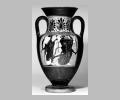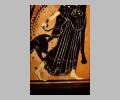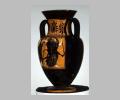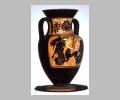| Collection: | University Museums, University of Mississippi |
| Summary: | Side A: Dionysos with satyr attacking maenad. Side B: Two dancing maenads. |
| Ware: | Attic Black Figure |
| Painter: | Attributed to the Diosphos Painter |
| Date: | ca. 510 BC - ca. 500 BC |
| Dimensions: | H. 0.20 m., D. 0.113 m. |
| Primary Citation: | |
| Shape: | Neck amphora |
| Period: | Archaic |
Decoration Description:
Side A: Dionysos, and satyr attacking a maenad. Dionysos stands at the left, in profile facing right. He holds a vine in his left hand and a drinking horn in his right. He is depicted as bearded, wearing a long chiton and himation, and a wreath in his hair. At the right, a satyr wearing a wreath attacks a maenad, who carries a thyrsos in her left hand. She wears a wreath, a chiton, and a panther skin tied around her shoulders. She reaches out toward Dionysos with her right hand.
Side B: Two dancing maenads. On each side of the composition a maenad dances, moving to the right. Both women wear wreaths, chitons, and panther skins tied around their shoulders. The maenad on the left holds a fawn by its front leg over her shoulder with her left hand, and she carries a thyrsos in her right. The maenad on the right holds a lion by the tail with her right hand and holds a vine in her left.
On each side of the vase, the body decoration is placed in a reserved panel, topped by a tongue pattern. The neck is decorated with three linked palmettes.
Dionysiac scenes without specific narrative content begin in Attic art circa 560. Satyrs and maenads are shown as the companions of Dionysos. The attack of the satyr shown on this vase is somewhat unusual. Scenes of the sexual pursuit of maenads by satyrs in the presence of Dionysos are uncommon. The thyrsos is first introduced in the late sixth century in red-figure work, and is rare in black-figure. The presence of the lion in a general Dionysiac context is another development of red-figure vase-painting which late black-figure artists adopt. Scenes of dancing maenads increase in late black figure after circa 520, and a symmetrical composition is generally favored.
In the early fifth century, when most vase-painters in Athens were using the red-figure technique, a group of painters continue to practice the black-figure technique. The Diosphos Painter, who specialized in decorating lekythoi and small neck-amphorae, is one such late black-figure painter. He is one of the few black-figure painters to decorate the doubleen, a special neck amphora with a reserved panel. The Diosphos Painter is consistent in his use of secondary decoration over the panel and on the neck of his doubleens. He uses a great deal of added white in his work, emphasizing color contrasts.
Shape Description:
The doubleen is a small neck amphora with a flaring mouth and double handles. On black-figure examples, the decoration is placed in reserved panels. The Diosphos Painter is one of the few black-figure artists to decorate this shape, which is best known in red-figure work, for example, by the Berlin Painter.
Essay:
Collection History:
Once in the Robinson collection. Harvard Inv. No. 124.
Sources Used:





